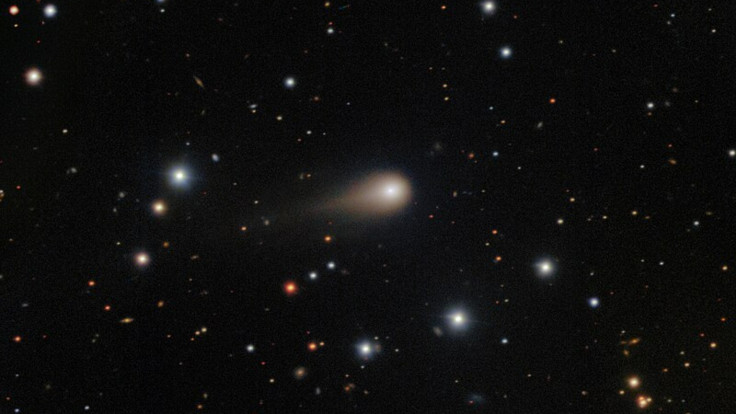
The search for extraterrestrial life has always been humanity's most tantalising tease, a cosmic carrot dangled just out of reach. We are a species obsessed with the question 'Are we alone?', scanning the heavens for a signal, a sign, or a stray piece of alien tech.
So, when NASA announced the release of high-resolution images of the latest interstellar visitor, expectations rocketed into the stratosphere. We were promised a glimpse into the unknown, a visual feast of an object traversing the void from a distant star system. Instead, the reveal landed with a dull thud, sparking confusion rather than clarity and igniting a firestorm of scepticism across the internet.

The Internet Strikes Back: Fury Over Fuzzy Photos
The anticipation was palpable. 3I/ATLAS, the third known interstellar object to grace our solar system, had been the subject of intense speculation since its discovery in July 2025. Yet, when the images finally dropped, the public reaction was less 'shock and awe' and more 'is this it?.' The photos, described by frustrated netizens as 'fuzzy white dots' and 'pixelated smudges', failed to provide the cinematic clarity many had hoped for.
Social media platforms erupted with sarcasm, with one viral post mocking the agency's efforts: 'NASA just dropped their 'groundbreaking' new images... It's a blurry white dot... Meanwhile, some dude in his backyard with a $500 Walmart telescope just stacked this absolute banger showing jets, tails, and structure clearer than NASA's entire press conference.' Critics and amateur astronomers alike took to social media, contrasting the agency's multi-billion dollar budget with the blurry output, accusing the establishment of gatekeeping the truth.
This wasn't just about bad photography; it was about the narrative. NASA described the object as a 'friendly solar system visitor', a standard comet behaving within expected parameters. However, this vanilla explanation clashed violently with the 'explosive breakdown' of data emerging from independent experts.
Harvard astrophysicist Avi Loeb openly criticised the release, stating that the agency was 'pretending to be the adults in the room' while offering no new insights, effectively 'gatekeeping' the raw data that could prove the object's artificial origins. The disparity between the official line and the observed oddities has fuelled a modern legend, suggesting that perhaps 3I/ATLAS is something far more complex than a dirty snowball.

12 Anomalies That Don't Add Up
To understand the fury, one must look at the data that refuses to fit the mould. 3I/ATLAS is simply too weird to be dismissed easily. Prominent voices, including Loeb, have catalogued a staggering list of 12 distinct 'unexplained anomalies' that defy conventional cometary physics. For instance, the object follows a retrograde trajectory aligned with the ecliptic plane—a coincidence with a mere 0.2% likelihood.
Even more baffling is its chemical signature. The gas plume emitted by the object is rich in nickel but strangely lacking in iron, a ratio unknown in our solar system's comets but common in industrial alloys. Specifically, the object releases roughly four grams of nickel per second without the expected corresponding iron—a signature that Loeb argues resembles 'industrially-produced nickel alloys' used in human manufacturing.
Furthermore, it displays a sunward jet, or 'anti-tail,' and exhibits non-gravitational acceleration that cannot be fully explained by outgassing alone. These features have led some to whisper the forbidden words: alien technology. While NASA dismisses these claims, the sheer volume of quirks keeps the debate alive. Is it a probe? A relic? Or just a freak of nature?
Grounded Reality: Indian Scientists Decode the Signal
Amidst the noise of online outrage and conspiracy theories, solid science continues to chip away at the mystery. Stepping into the fray, Indian scientists have observed the mysterious interstellar comet 3I/ATLAS, providing a fresh perspective from the ground. This observation was made by scientists from the Physical Research Laboratory part of ISRO, using their 1.2-metre telescope at Mount Abu.
Conducting their watch between November 12 and 15, 2025, the team managed to capture the object as it sped away from the Sun. Their findings inject a dose of grounded reality into the wild speculation. The Mount Abu images revealed a near-circular coma—the nebulous envelope of gas and dust—surrounding the nucleus.
More importantly, their spectral analysis identified the object's chemical fingerprint. The data showed prominent emission bands of CN (cyanogen), C2 (diatomic carbon), and C3 (triatomic carbon).
These are the classic signatures of a solar system comet, suggesting that despite its alien origins, 3I/ATLAS is made of familiar stuff. The calculated production rates of these molecules place it squarely in the category of 'typical comets.'
While this might dampen the sci-fi enthusiasm for an alien spacecraft, it raises a profound scientific point: chemistry might be universal. Whether born from our Sun or a distant, dying star, the building blocks of the cosmos appear remarkably similar.
The debate over 3I/ATLAS sits at the precise intersection of our wildest dreams and cold, hard data. While the spectral bands point to a familiar cosmic recipe, the anomalies—that strange nickel-to-iron ratio and the defiance of gravity—continue to whisper a different story.
Perhaps the truth isn't about choosing between a dirty snowball and an alien probe, but realising how much we have yet to learn about our galactic neighbourhood. As the object fades into the dark, it leaves us with more questions than answers, reminding us that the universe rarely gives up its secrets easily.







